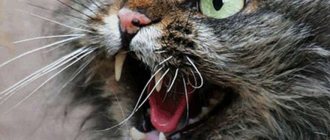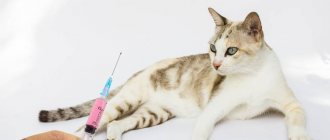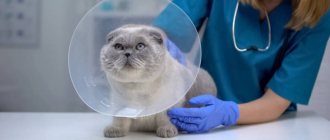Currently, rabies (hydrophobia) belongs to the category of the most dangerous infectious diseases, which affects the central nervous system and parts of the brain. Pets, in particular cats, are especially susceptible to the above disease. And if a cat, for one reason or another, becomes infected with rabies, then, alas, it is not possible to save his life. That is why it is important to know about methods of protection against rabies and preventive vaccination of domestic and outdoor cats.
Source of rabies
The causative agent of the disease, which is fatal to cats, is the Rabies virus . It is he who disorganizes the work of the central nervous system. Having penetrated the body, the rabies pathogen moves along nerve fibers to the brain, and then rushes to the salivary glands. In them it accumulates and multiplies.
Moreover, the virus has strong immunity: at a temperature of 90 degrees Celsius it can live up to 14 days, and even longer when exposed to cold.
For this reason, cat owners should carefully ensure that their pet does not pick up any food from the street.
How the virus works
Rabies is an infectious disease that affects humans, wild and domestic animals. The causative agent is a virus called Rabies virus, belonging to the Rhabdoviridae family.
When microorganisms enter the bloodstream, they begin to multiply rapidly, first attacking the excretory system, and then affecting the spinal cord and brain. The effect of Rabies virus on neurons leads to their gradual atrophy, which is accompanied by certain symptoms. Rabies cannot be treated and the result is death.
How does infection occur?
A cat can be infected with rabies only through saliva , while eliminating the risk of infection through blood or urine. Moreover, a sick animal does not necessarily have to bite a cat. If the saliva of an infected organism suddenly ends up on a cat’s wound or scratch (even if it is small), then there is already a serious possibility of developing hydrophobia. Hypothetically, a pet could get rabies simply by licking its owner's shoes, since it is quite easy to bring saliva from an infected animal from the street.
When eating rats or mice infected with rabies, the likelihood of the cat becoming ill is quite high.
Causes of the disease
The main route of transmission of the virus from a sick cat to a healthy one is through saliva, since the maximum concentration of this virus is found in it. Saliva mainly enters wounds and the bloodstream through bites, but can also enter the body through mucous membranes and even, according to some sources, through intact skin when licking each other. Cases have been described in which domestic cats that lived in a private house outside the city, but did not have contact with other cats and dogs, were found to have the rabies virus. It was determined that the infection occurred after forest urchins ate from their bowls and left their saliva there. It is also not uncommon to find signs of rabies in cats that catch and eat infected rodents.
In the United States, cases of airborne infection have been reported after visiting caves that are densely populated by bats, but not everyone who visited the cave became ill. Also, in laboratory conditions, it was possible to achieve infection through the oral route by ingesting contaminated food and water. But so far, both of these transmission routes remain controversial.
Incubation period
From the moment of infection until the appearance of primary signs of rabies, an average of 21–42 days . However, the duration of the incubation period depends on several factors: location, localization, size of the bite, age. For kittens, the above time period is 6–7 days . But even after this period, it is not always possible to determine exactly whether a cat has rabies.
Once a case was recorded when, only 6 months after the bite, specialists were able to diagnose a fatal pathology in a cat.
The smaller the bite area and the further it is located from the pet’s brain, the longer the incubation period for the virus. Not least important here is the dose of the virus in saliva.
Even a cat that has been vaccinated against rabies at one time can potentially become an object of infection (especially if the vaccination was done more than six months ago).
Important! There are cases when, even after a control period of time, nothing suspicious is detected in the pet’s behavior, but its saliva is, de facto, toxic. This is why it is recommended to quarantine your cat immediately after being bitten and seek immediate treatment from your local veterinarian. Ignoring these measures risks infecting the owner himself with rabies, and treatment of this dangerous disease can turn into a long and painful procedure.
What to do if a rabid cat bites a person
Rabies is very dangerous not only for animals - if you miss the deadline when something can be done, then death cannot be avoided.
People also become infected with the virus through the bites of sick animals. The closer the bite site is to the veins, the faster the virus will reach the brain. The disease progresses especially quickly in children, so the wound is immediately washed with soap and immediately contacted by a rabiologist for treatment.
The incubation period lasts on average 1-3 months with the same stages as in cats. Self-medication at home is unacceptable, but timely anti-rabies treatment will allow a person to live healthy for many years.
General signs of infection
A characteristic feature of the virus is the fact that after entering the body, it may not manifest itself for weeks or even months. As a rule, the initial symptoms occur when the disease is firmly rooted in the body and subjugates the main vital systems.
There are some changes in the cat's behavior:
- excessive aggressiveness accompanied by anxiety;
- suspicious calm;
- slow reaction;
- unusual screams;
- meowing too often;
- systematic paralysis, convulsions;
- loss of appetite;
- photophobia (the cat hides in dark places);
- increased salivation.
The above list is not exhaustive and the manifestation of certain signs depends on the degree of infection of the pet.
Last stage
The final stage of the disease lasts up to 5 days. Paralysis occurs throughout the body, starting with the jaw and tail. The cat no longer eats, drinks, meows and is losing a lot of weight. Then death comes.
The danger of animals with rabies is that they become infectious several days or even weeks before the first symptoms appear. From the moment the virus enters the body until the first symptoms appear, a certain time always passes, which is called the incubation (latent) period. And when symptoms of rabies in a cat already appear after a bite, this means that death will soon occur.
Forms of disease development and their symptoms
There are several variations in the development of rabies in a domestic animal, the causative agent of which is a virus. Moreover, in kittens the stages of the disease in question are the same as in adults, but they proceed somewhat faster.
Paralytic (silent) form
The period of this type of disease is 3-4 days . Moreover, no deviations are observed in the pet’s behavior , except for the fact that he is systematically overcome by attacks of affection . However, one should not show loyalty to such friendliness on the part of the cat, since its saliva is poisoned by the virus.
Those at greatest risk are children who, noticing the playful mood of the cat, begin to stroke and pick it up. During the period of a silent form of rabies, your pet may experience drooping of the lower jaw and increased salivation .
Soon paralysis of the larynx sets in, and the cat begins to choke. Family members naively believe that there is simply a bone stuck in the pet’s throat and begin to try to remove it with their own hands. Only after several unsuccessful attempts do they decide to take the cat to the veterinarian, who subsequently informs them of the terrible diagnosis.
Violent form
The duration of this variation in the development of rabies varies from 3 to 11 days . It is characterized by even more pronounced symptoms. The first sign indicating that rabies has become violent is a significant change in the cat’s behavior, which is no longer explained. There are three stages here.
Prodormal
Symptoms indicating this stage are quite difficult to determine. In essence, we are talking about the incubation period, the specifics of which were described above. A rabid cat loses its appetite , it shuns the light and makes every attempt to retire . She develops an unusual hobby: tasting inedible things - paper, curtains, tree bark, etc. As already emphasized, in the initial stage of infection, a pet may show excessive playfulness and friendliness , so this behavior should be alarming in the first place.
Manic
The signs by which this stage can be determined are pronounced, so recognizing it will not be difficult. Any noise and commotion from others provokes an open attack of aggression in the cat. At this moment, he is ready to rush at the first one who catches his eye. In time, the manic stage is short-lived: only a few hours , which can transform into a maximum of 2-3 days .
The animal clearly exhibits a “gnawing” reflex . The cat takes into its mouth everything it comes across, starting with slippers and ending with a broom. Moreover, she doesn’t just take bites, but tries to squeeze her jaws as tightly as possible . The pet is systematically subjected to bouts of unexpected and sudden attacks on family members, which is fraught with serious bites for them, through which rabies is transmitted.
In addition, the animal's swallowing reflex is impaired , resulting in increased salivation. Eating and drinking become difficult for the cat. The animal begins to experience real fear when it hears the sound of water.
Depressed
At the final stage of the development of rabies, which lasts 5–7 days , paralysis of the larynx and pharynx . The voice ceases to be loud, then disappears altogether, and the body gradually loses the ability to move. The aggressive reflex is reduced to a minimum. The animal's body becomes exhausted and it dies.
Atypical form
This type of rabies development is classified as rare , although its duration sometimes reaches several months. It is difficult to determine the atypical form, since the symptoms are mild . The pet experiences drowsiness, lethargy, and depression. The cat suffers from intestinal dysfunction, resulting in loose bowel movements with blood and vomiting. The pet's body is seriously depleted.
Light form
It is also called silent and is also known as the paralytic form. It differs in that the symptoms described above are not noticeable, since they do not appear clearly. In some cases, the owner manages to find out about the disease by closely monitoring the pet. He may become more affectionate if he previously did not show much interest in people and did not caress, tries to be constantly nearby, tries to sleep on the person’s body.
In this case, rabies in cats and the symptoms are hidden. The disease manifests itself unexpectedly and sharply, the signs become:
- pharynx paralysis;
- increased salivation;
- the cat is trying to cough something up;
- the animal appears to be choking.
At this point, it is already useless to look for how to determine rabies in a cat and methods of treatment, since after 2-4 days the individual will die.
What to do if you suspect rabies?
If you have serious reasons to believe that your cat may be infected, take the following measures immediately
- complete refusal of contact with the animal and 100% isolation of the latter (in a separate room);
- if the cat has bitten or scratched the skin, then urgently wash the wound using laundry soap;
- contacting a veterinary clinic and consulting with a specialist about your pet’s symptoms.
Important! Neglecting the above recommendations may result in infection with the rabies virus.
First stage
At the first stage, a mad cat may look like a completely healthy animal. The initial stage suggests that the symptoms of rabies in cats may be mild: the animal may only lose its appetite, begin to hide in secluded places, or, conversely, show unusual affection. But the owner attributes this to one or another reason. After all, there are many diseases that cause such conditions. Also, rabies in cats at the initial stage can manifest itself as eating inedible objects: furniture, wallpaper, toys.
Diagnostics
As has already been emphasized, it can be very difficult to determine as accurately as possible that a cat is infected with rabies. In most cases, the veterinarian resorts to specific actions only when, after analyzing the pet’s symptoms, he concludes that he is sick with something other than the rabies virus.
Otherwise, the veterinarian chooses a wait-and-see approach until the animal is declared dead. Only after this the specialist begins to study the animal’s brain tissue to find out whether its structure contains the “Babesh-Negri” body. If the test is positive, everyone who previously had contact with the cat is prescribed appropriate therapy.
The corpse of an infected pet is necessarily burned.
As for medications that would relieve a pet from rabies, humanity has not yet invented them.
Is there a cure for rabies in cats?
No matter how painful it is to watch an animal suffer, it is impossible to help the cat. There is no treatment for rabies. In veterinary medicine, it is prohibited to treat infected animals, since the probability of a positive outcome tends to zero, and the risk of contracting the virus to those who come into contact with the pet is high. Regarding people, medicine is also powerless . When the first signs of rabies appear, a person can rarely be helped.
Prevention measures
The most effective way to minimize the risk of infection in a cat is through vaccination. The cost of vaccination against the virus is 700–900 rubles.
The veterinary market offers several effective remedies that reduce the risk of rabies infection. We are talking, in particular, about “Nobivak Rabies”, “Quadriquet”, “Rabican”, “Leucorifeline”. All of them have virtually no side effects, but the most popular is the first of these drugs.
At what age is it recommended to start vaccination? As soon as the kitten turns 3 months old. Moreover, your pet needs to be vaccinated annually. You can read about how to inject your cat yourself in our article.
Rabies vaccination is a free service that is provided by all budget veterinary clinics without exception.
Vaccination is not advisable if:
- pregnancy or if the cat has just lambed;
- the presence of helminths in the body (before vaccination, all parasites must be removed);
- if the kitten has not had teeth replaced;
- the animal is injured.
Important! In all civilized countries of the world, cats are required to be vaccinated against rabies. And if the pet’s owners ignore this rule, then they will not be able to leave the country with it. Also, a pet will not be allowed to the exhibition if there is no corresponding vaccination mark in the veterinary passport.
Second stage
The second stage is chaotic. A rabid cat behaves like an angry animal: nervousness, attacks of aggression, and timidity appear. A cat can suddenly attack a person, inflicting severe bites. Convulsions and paralysis of the masticatory muscles, as well as the muscles of the larynx, develop, constriction of the pupils, and fever reaches a maximum. The stage lasts from 2 hours to several days.
At this stage, the signs of rabies in the cat progress. A sick animal meows a lot due to spasm of the larynx. The cry of a mad cat is changed, that is, the owner notices that the animal’s voice is somehow different. The cat is no longer able to swallow saliva, food, or water. This is the condition for which rabies is called hydrophobia. For example, if a person in this state is given a glass of water, he will not be able to swallow and will make chaotic movements - from the outside it looks like an animal fear of water. For cats, if they could hold a glass of water in their paws, it would look something like this. Due to paralysis of the lower jaw in cats, the mouth becomes slightly open.
Hydrophobia with rabies in cats is a common symptom, but it is by no means the first by which, along with foam at the mouth and aggression, many try to judge the presence of rabies. Moreover, it does not appear in everyone.
Useful video:
A veterinarian's opinion about rabies in cats: the course of the disease and its symptoms.
Today, the rabies virus poses perhaps the greatest threat to animals and humans. Megacities are especially susceptible to episodic outbreaks of rabies, and it would be naive to expect that living remotely from them will guarantee one’s safety for life and health.
Every day, about 100 people die from hydrophobia. This figure exceeds 50,000 per year, and the number of dead animals amounts to several million. These terrifying statistics are explained by the fact that in 99% of cases, pets infected with rabies do not survive.
It is for this reason that your pet needs to be systematically vaccinated to minimize the risk of contracting hydrophobia.











